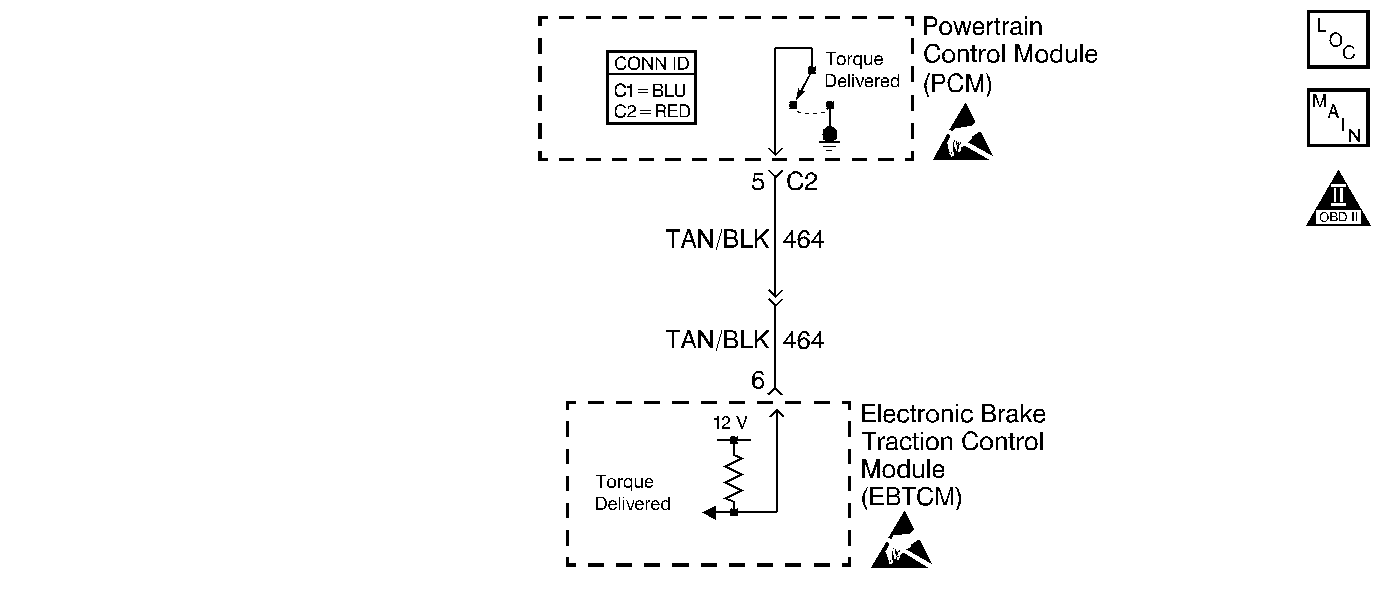
Circuit Description
The Electronic Brake and Traction Control Module (EBTCM) supplies 12.0 Volts on the Delivered Torque circuit to the PCM. The PCM toggles this 12.0 volt signal to a ground in order to produce a duty cycle signal. The signal is proportional to the amount of engine output torque reduction . In order to reduce engine output torque, the PCM reduces the amount of spark advance and in some cases the PCM disables a number of fuel injectors. This diagnostic tests for a Delivered Torque signal failure. If the PCM does not receive the Delivered torque signal, this DTC sets.
Conditions for Running the DTC
| • | The traction control has not failed. |
| • | The engine speed is greater than 500 RPM for 20 seconds. |
Conditions for Setting the DTC
The PCM does not receive the Delivered torque signal for 3 seconds.
Action Taken When the DTC Sets
| • | The powertrain control module (PCM) stores the DTC information into memory when the diagnostic runs and fails. |
| • | The malfunction indicator lamp (MIL) will not illuminate. |
| • | The PCM records the operating conditions at the time the diagnostic fails. The PCM stores this information in the Failure Records. |
Conditions for Clearing the MIL/DTC
| • | A last test failed, or the current DTC, clears when the diagnostic runs and does not fail. |
| • | A history DTC clears after 40 consecutive warm-up cycles, if failures are not reported by this or any other emission related diagnostic. |
| • | Use a scan tool in order to clear the MIL/DTC. |
Diagnostic Aids
Important:
• Remove any debris from the PCM\TAC module connector surfaces before
servicing the PCM\TAC module. Inspect the PCM\TAC module connector gaskets
when diagnosing/replacing the modules. Ensure that the gaskets are installed
correctly. The gaskets prevent contaminate intrusion into the PCM\TAC
modules. • For any test that requires probing the PCM or a component
harness connector, use the Connector Test Adapter Kit J 35616
. Using this kit prevents damage
to the harness/component terminals. Refer to
Using Connector Test Adapters
in Wiring Systems.
| • | The following may cause an intermittent: |
| - | Poor connections; Refer to Intermittents and Poor Connections Diagnosis in Wiring Systems. |
| - | Corrosion |
| - | Mis-routed harness |
| - | Rubbed through wire insulation |
| - | Broken wire inside the insulation |
| • | For an intermittent condition, refer to Symptoms . |
Test Description
The numbers below refer to the step numbers on the diagnostic table.
-
This step determines if the PCM is receiving the 12.0 volts from the EBTCM.
-
This step is testing for a short to ground on the Delivered Torque circuit.
Step | Action | Value(s) | Yes | No | ||||
|---|---|---|---|---|---|---|---|---|
1 | Did you perform the Powertrain On-Board Diagnostic (OBD) System Check? | -- | ||||||
2 |
Important:
Are any ABS/Traction Control DTCs set? | -- | Go to applicable DTC | |||||
Does the DMM display near the specified value? | B+ | |||||||
4 |
Does the DMM display continuity? | -- | ||||||
Test for continuity from the Delivered Torque circuit to ground using the DMM J 39200 . Refer to Testing for Continuity in Wiring Systems. Does the DMM display continuity? | -- | Go to Diagnostic System Check - ABS in Antilock Brake System | ||||||
6 | Repair the Delivered Torque circuit for an open or a short to ground. Refer to Wiring Repairs in Wiring Systems. Is the action complete? | -- | -- | |||||
7 |
Did you find and correct the condition? | -- | ||||||
8 |
Important:: Program the replacement PCM. Refer to Powertrain Control Module/Throttle Actuator Control Module Replacement . Replace the PCM. Is the action complete? | -- | -- | |||||
9 |
Does the scan tool indicate that this test ran and passed? | -- | ||||||
10 | Select the Capture Info option and the Review Info option using the scan tool. Does the scan tool display any DTCs that you have not diagnosed? | -- | Go to applicable DTC | System OK |
